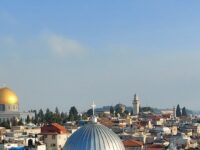The way of suffering leading to resurrection – The Via Dolorosa
From the inception of Christianity, believers have sought to pinpoint the locations where Jesus spent his final days and moments, particularly tracing the path he took bearing the cross from the site of his trial to the crucifixion spot. Initially, this task seemed straightforward. However, the destruction of Jerusalem during the Great Revolt (70 AD, 37 years after Jesus’ crucifixion) and again in the Bar Kochva Revolt (135 AD), followed by the construction of the Roman city of Ilia Capitolina on its ruins—a place where Christians faced persecution—complicated these efforts significantly.
Following the Roman Empire’s shift to Christianity in the 4th century AD, Helena, Emperor Constantine’s mother, pinpointed the sacred sites, initiating the practice of retracing the steps of Jesus’ Passion. The initial processions embarked from Gethsemane, moving towards Mount Zion, reputed to house Caiaphas the high priest’s home, where Jesus faced trial before the Jewish Sanhedrin after his Gethsemane arrest. The journey from Mount Zion led to the Tower of David, recognized as Herod’s palace and the location of Antonia’s fortress, where Jesus was presented to Pontius Pilate, the Roman governor of Judea, for trial on Friday morning. Consequently, the Tower of David region was viewed as the site of Jesus’ sentencing, scourging, crowning with thorns, and cross bearing, marking the outset of the Passion. From there, the processions advanced towards the crucifixion site at the Church of the Holy Sepulchre. Initially, the early Byzantine tradition did not designate stations along this path.
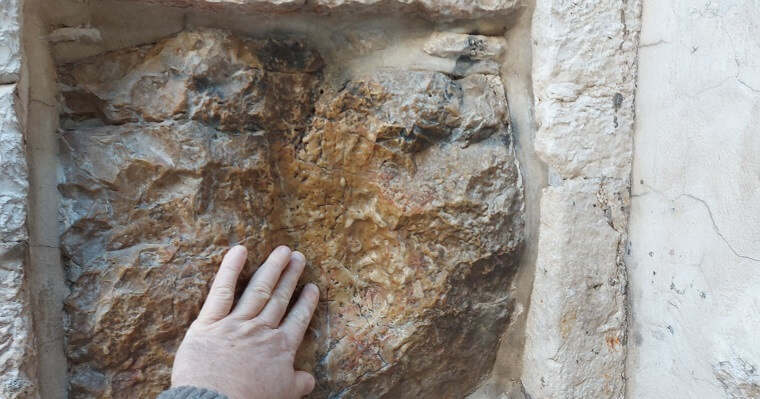
Archaeologist Dan Bahat notes that the concept of the Via Dolorosa was first introduced by the Crusaders, though the stations they recognized differ from those established in the 14th and 15th centuries. Essentially, the Crusaders traced Jesus’ path differently, beginning at the Last Supper’s location on Mount Zion, descending to Gethsemane for the betrayal scene, proceeding to the trial site before the high priest Caiaphas, and then to Pontius Pilate’s trial location, likely near David’s Citadel. Throughout this route, they commemorated Jesus’ sentencing, scourging, the imposition of the crown of thorns, and bore the cross from the trial site to the crucifixion place.
The path of suffering begins at the site of Jesus’ trial within Pontius Pilate’s palace and fortress, extending to Calvary’s crucifixion site. The exact location of the ruler’s palace poses a historical question. During the Crusades, a palace for the Crusader kings was constructed north of the David’s Citadel, which was refurbished and dubbed the City’s Citadel. These sites, in popular belief, became linked with the judgment venue, suggesting that processions bearing the cross, emulating Jesus’ Passion, might have originated from Mount Zion or the palace adjacent to David’s Citadel, proceeding then to the Church of the Sepulchre, diverging from today’s established route.
However, it’s my belief that the precise path holds lesser significance compared to the journey’s outcome – the experience of transition from one location to another, a transformative process, and the embodiment of Jesus’ suffering and sacrifice along this path. By traversing the Via Dolorosa, participants are afforded a deeper connection to Jesus’ message and life.
Conversely, the Templars repurposed the Dome of the Rock into a Christian church, naming it the “Temple of the Lord.” This site became the epicenter for the Knights Templar and their emblem during the First Kingdom of Jerusalem, ranking it as the second most pivotal Christian location in Jerusalem, following the Church of the Holy Sepulchre. Crusader era maps depict Jerusalem as a circle enclosing two smaller identical circles: one representing the Temple of the Lord (the Dome of the Rock) and the other, the Church of the Holy Sepulchre. It’s logical to infer (and historical evidence supports) that religious processions linked these two sites, possibly related to Jesus’ Passion. This connection might shed light on the origins of the current Via Dolorosa route, which extends from the Antonia Fortress north of the Temple Mount, moving east-west towards the Church of the Holy Sepulchre. Nonetheless, the formation of this route postdates the Crusades, coinciding with the 14th century AD founding of the Franciscan Order and the Custodia de Terra Santa in Jerusalem.
Following the Crusades, control of the Temple Mount reverted to Muslim authority, yet the tradition of east-to-west processions from the Temple Mount vicinity to the Church of the Holy Sepulchre persisted. The Franciscan Order upheld the Catholic presence in the Holy Land, taking on the role of custodians for the Christian holy sites and founding the Custodia de Terra Santa. From the 14th century onward, they began to map the pilgrimage routes to the Holy Land, defining its sacred geography. Within this context, they recognized the area north of the Temple Mount as the location of Herod’s palace and the Antonia Fortress, established the current Via Dolorosa route with its 14 stations.
Ever since, the Franciscans have hosted a procession every Friday, the day commemorating Jesus’ Passion and Crucifixion, where they bear a large cross and recite prayers at each station. Throughout the rest of the week, groups of pilgrims, shouldering large wooden crosses, also make their way from the Franciscan compound’s picturesque courtyard at the second station to the Church of the Holy Sepulchre.
The adage suggests that suffering brings one closer to oneself. It’s crucial to recognize that while the processions are public, the journey of suffering is a deeply personal odyssey. The stations prompt introspection, linking Jesus’ suffering to our own internal battles—as each person bears their own cross. Yet, through this, we can discern meaning in suffering, anchored in the belief that it propels us towards a destination where revival and the emergence of something new await. Like any birth, this emergence is intertwined with pain and agony. This insight fosters a patience in enduring hardships, not a passive endurance but one born of understanding and love.
Understanding Jesus’ passage through suffering as necessary for participating in and redeeming human fate is key. The Son of God had to experience human affliction to bring light and solace to the darkest corners of the earth. His path of suffering took him to the underworld, liberating the souls of the righteous trapped there, offering them redemption unavailable since the beginning of time. Jesus’ death and descent were prerequisites for this liberation. His resurrection paves the way for humanity’s own rebirth and salvation. Thus, agony and suffering are precursors to redemption and resurrection, one inseparable from the other.
Christianity, by sanctifying suffering, offered hope to countless individuals enduring hardship, presenting redemption as a potential outcome of human affliction. Similarly, Buddhism tackles the issue of suffering, albeit from a distinct perspective. Christianity infuses suffering with love and sacrifice, attributing emotional significance to it. The journey of suffering is an intimate voyage, where the stages encountered stir deep emotions. The trials of Jesus resonate with our personal tribulations, urging us to find meaning within them. This significance is tied to notions of revival and rebirth, transforming adverse experiences into improved understanding and spiritual enlightenment.
In recent years, there have been efforts to imbue the 14 stations with additional, especially allegorical and mystical, interpretations. Attempts have even been made to reconfigure the stations by adding or removing some, with Pope John Paul II being a notable figure in this endeavor. He suggested modifications to some stations to align the route more closely with New Testament narratives rather than later traditions. However, one doesn’t need to be the pope to inject meaning into Jesus’ path of suffering or to understand the act of bearing the cross in an allegorical sense. We all bear our crosses, and individuals from various religious backgrounds can seek to interpret the different stages along this path. This is precisely the approach I adopt in the book presented to you.
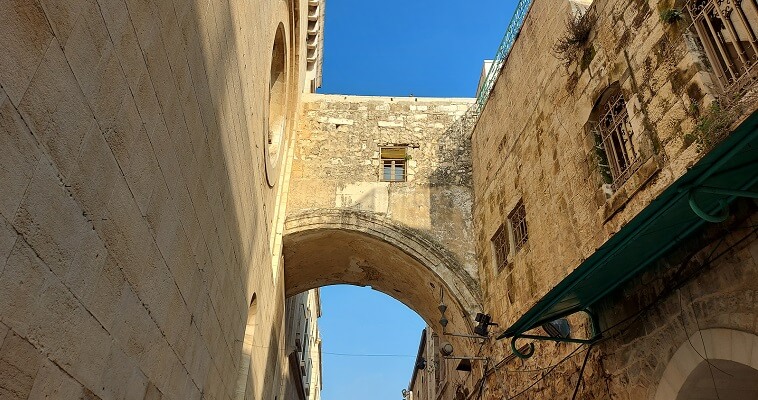
Stations of the Via Dolorosa
In this context, I find particular stations along the Via Dolorosa to hold profound mystical significance. The journey begins with the first two stations, located in the Franciscan courtyard and adjacent to a school, marking the sites of Jesus’ condemnation, flagellation, and the laying of the cross upon him. The third station, situated at the journey’s conclusion beyond the Ecce Homo arch and the Convent of the Sisters of Zion, signifies where Jesus first stumbled, denoted by a modest chapel.
Close by, within a building, lies the fourth station, where Jesus is said to have encountered his mother. This moment is symbolized by a mark on the street and further commemorated in the basement of the Armenian Catholic Church, known as the “Church of Our Lady of Sorrows.” The narrative of Mary meeting Jesus as he bore the cross emerges later in tradition. Locals may present mosaics depicting a pair of feet, asserting the antiquity of this spot where Mary supposedly stood. Subsequently, Jesus predominantly interacts with women along his path—Veronica at the sixth station, the women of Jerusalem at the eighth, and his mother once more at his crucifixion. This pattern suggests the feminine essence envelops Jesus’ sacrifice, lending it profound emotional resonance. It provokes reflection on what might have transpired during Jesus’ supposed meeting with his mother at the fourth station.
The fifth station marks the point where the pathway ascends towards the Christian quarter and is associated with Simon of Cyrene. The New Testament recounts, “And they compel one Simon a Cyrenian, who passed by, coming out of the country, the father of Alexander and Rufus, to bear his cross” (Mark 15:21). Observing Jesus struggling to carry the cross uphill, Roman soldiers coerced a bystander witnessing the grim scene to take up the cross for Jesus. This bystander was Simon of Cyrene. However, the narrative suggests that this role could be assumed by any one of us, highlighting our collective responsibility to assist in bearing the world’s burdens, as epitomized by Francis of Assisi. The founder of the Franciscan order beseeched God for the strength and love to partake in Jesus’ sufferings, culminating in him receiving the stigmata, the miraculous appearance of Christ’s crucifixion wounds on his own body.
Gnostic texts, representing a Christian mystical sect from the 2nd to 3rd centuries AD with their own gospels, offer an alternative narrative. They propose that Jesus seized the moment to vanish into the crowd, leading a long life up to the age of 120 years, possibly even traveling to India. According to these sources, the unfortunate individual ultimately crucified was Simon of Cyrene. Cyrene, incidentally, is located in northern Libya and was home to significant Jewish communities.
The notion of aiding Jesus in bearing his cross, epitomized by Simon of Cyrene, emerged within certain Catholic contexts as a metaphor for assisting others with their burdens, an act described as “exchange.” This concept involves someone, either through choice or destiny, absorbing the world’s afflictions. Miriam Bouardi, who experienced visions of Mary in the late 19th century, was regarded by scholar Louis Massignon as embodying such an exchange, a role that explained her premature demise and sufferings.
The placement of Simon of Cyrene’s encounter as the fifth station is significant, hinting at a deeper symbolism. Jesus sustained five wounds during his crucifixion, a figure mirrored in the Franciscan order’s emblem, prominently displayed throughout the Via Dolorosa: five crosses, with the central one being the largest. The number five represents humanity, reflecting the five senses and body extensions (two arms, two legs, and a head), with its geometric counterpart being the pentagram, as depicted in Leonardo da Vinci’s Vitruvian Man. In this context, Jesus epitomizes “the man,” a theme echoed in the Ecce Homo narrative (“behold the man”), associated with a large arch marking the Via Dolorosa’s start, under which Jesus, and subsequently all pilgrims, pass.
The sixth station on the Via Dolorosa commemorates Saint Veronica, whose name signifies “true image” (Vero Icon). At this spot, a compassionate woman, moved by the sight of Jesus struggling uphill with the cross, offered him a cloth to wipe his brow. Astonishingly, Jesus’ visage was transferred onto the fabric, rendering it one of Christianity’s most venerated relics. Although Veronica’s act is not chronicled in the New Testament and likely wasn’t part of the original Passion narrative during the Crusades, relics bearing Jesus’ likeness emerged earlier in Europe and Byzantium, becoming integral to the pilgrim’s faith. By the early 13th century, Veronica’s veil was being displayed in Rome, suggesting that the tradition had also reached Israel by that time.
This event mirrors the Annunciation and Incarnation miracles, arising from Veronica’s compassion towards Jesus. Some equate Veronica with the woman healed by touching Jesus’ garment in Galilee. Jesus, sensing her touch, assures her, “Daughter, be of good cheer; thy faith hath made thee whole,” leading to her immediate healing (Matthew 9:22). Veronica and the Galilean woman’s stories teach the importance of reaching out to Jesus, highlighting that he awaits such gestures and that genuine faith can yield miraculous outcomes.
At the location of Veronica’s sixth station, Barluzzi constructed a charming chapel for the Malachite Greeks, adjacent to which is a space hosting an iconography studio, operated by French nuns. Here, they bring to life the visages of Jesus and the saints through paint and brush on wooden panels, embodying a form of sacred and miraculous artistry, particularly when adhering to the traditional practices of icon painting—a topic for another discussion.
Just beyond, you’ll find the seventh station, known as the Gate of Judgment, and not far off, the eighth station, where Jesus encounters the women of Jerusalem who mourn for him. He addresses them, saying, “Daughters of Jerusalem, weep not for me, but weep for yourselves and for your children. For, behold, the days are coming, in which they shall say, Blessed are the barren, and the wombs that never bore, and the breasts which never nursed. Then they shall begin to say to the mountains, Fall on us; and to the hills, Cover us. For if they do these things in a green tree, what will happen in the dry?” (Luke 23:28-31). This marks Jesus’ final interaction with the women of Jerusalem, who express compassion and support, contrasting sharply with the depiction of a crowd clamoring for his death.
In Christian belief, Jesus is likened to a moist, living tree, in contrast to those disconnected from spiritual enlightenment, who are compared to dry trees unable to bear fruit and destined for burning. Christianity posits two pathways for humanity: to shoulder Jesus’ cross, joining the tree of life, or to reject him, remaining a barren tree. Concurrently, it’s essential to acknowledge that the Second Vatican Council, the most recent ecumenical council, affirmed the existence of truth and pathways to it outside Christianity, urging Christians to respect all faiths, with particular emphasis on Judaism.
The acceptance or rejection of Jesus, in my view, pertains not to his personal identity but to the ideals he symbolizes. Over two millennia since Jesus’ death, the Jewish people have endured suffering at Christian hands, learning to bear their trials with patience, maintaining hope for the Messiah’s arrival and Jerusalem’s restoration. Their journey through exile, marked by perseverance in the face of persecution and hardship, mirrors the carrying of a cross. The Via Dolorosa and Jerusalem at large serve as contemplative backdrops for reflecting on the burdens borne, whether Jesus’ cross from 2,000 years ago or the enduring trials of a people through two millennia of exile and adversity. Such reflection fosters a renewed admiration for human resilience and, specifically, marvel at the enduring spirit and vitality of the Jewish people.
The Passion of Jesus concludes at the Church of the Holy Sepulchre, home to Stations 10-14 on the Via Dolorosa (with Station 9, marking Jesus’ third fall, situated on the roof and alley above the Church). During the Middle Ages, the Church of the Sepulchre stood as the ultimate goal for pilgrims, knights, dreamers, and mystics. It remains, to this day, the most significant site for those journeying to the Holy Land.
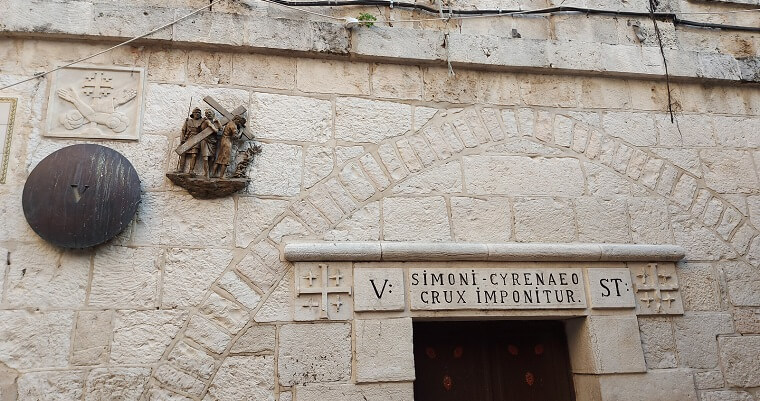
Church of the Condemnation and Imposition of the Cross
The Via Dolorosa, or Way of Suffering, is a pilgrimage path in Jerusalem’s Old City, extending from Jesus’ trial site at the Antonia Fortress, north of the Temple Mount—a place also regarded as the conviction site—to the Church of the Holy Sepulchre, marking the crucifixion and resurrection locations. However, the pilgrimage typically commences at the Via Dolorosa’s second station, the site of Jesus’ conviction, flagellation, and crowning with thorns. Pilgrims journey from the Franciscan compound’s picturesque courtyard to the Church of the Sepulchre. They progress in groups, pausing at each station to pray and carry a large cross, mirroring Jesus’ own crucifixion path. These stations commemorate the Passion’s events, a practice that originated in the 14th century. This tradition has been solidified and disseminated over time, with representations of the Via Dolorosa’s 14 stations found in every Catholic church today.
The initial stage of the Via Dolorosa, marking the trial and conviction site, currently resides within the premises of the Omaria Muslim School, housing the remnants of the Antonia Fortress and the praetorium (the Roman legion’s headquarters that maintained order in Jerusalem and where Pontius Pilate conducted Jesus’ trial). Access to these remains is challenging, but for those determined, a ramp leads from the street to a blue door (entry requires permission), opening to an elevated courtyard within the school, offering a view of the Temple Mount from the north. However, it’s not a site for Christian worship, and conducting prayers or rituals there is not feasible.
Directly opposite the school, across the street, lies a spacious and elegant courtyard owned by the Franciscans. Surrounding this courtyard are several notable buildings: Barluzzi’s Crown of Thorns Chapel (Church of the Flagellation), the Franciscan Church of the Condemnation and Imposition of the Cross, and the Franciscan Bible School’s facilities, including the Studium Biblicum Franciscanum, Research Institute, school of theology, Franciscan Archaeological Museum, and subterranean chambers showcasing relics and an audio-visual presentation of the era of Jesus. This setting serves as an ideal location for prayer, ceremonies, and preparing for the Via Dolorosa pilgrimage. The courtyard and churches offer tranquil spots for quiet reflection on the Mysteries of the Scourging at the Pillar and the Crowning with Thorns, with purity, the humbling of the senses, and moral bravery as the spiritual fruits derived from these Mysteries.
Christian lore recounts that steps led from the square in front of the Antonia Fortress (site of the Franciscan courtyard) into the fortress itself (location of the Omaria School), where Pontius Pilate conducted trials. Jesus climbed these steps en route to his trial and descended them post-conviction. These steps, known as the “Scala Sancta,” were purportedly transported to Rome by Queen Helena in the 4th century AD and installed in the papal palace. Presently, they are situated within the Basilica of St. John Lateran complex in Rome, where pilgrims ascend them, often on their knees, as a devotional act.
The Church of the Condemnation and Imposition of the Cross is intertwined with the Mystery of the Scourging at the Pillar. This church, constructed in the early 20th century, features a traditional Italian facade and Baroque architecture, including five domes and stained glass windows depicting the Passion of Jesus. Within, a painting captures a long-haired woman, possibly Mary Magdalene, attempting to glimpse inside a building, while John the Baptist obstructs her view to spare her from witnessing Jesus’ scourging. The church’s central apse showcases a combined work of painting and sculpture depicting Jesus descending the sacred steps, with Pontius Pilate observing from above.
Within the Church of the Condemnation and Imposition of the Cross, visitors can observe the paving stones that were part of an extension beneath the Antonia Fortress, where the steps leading up to it began (the original site of the holy stairs was located 50 meters east of this point). The church’s central apse features a depiction of these stairs, flanked by two smaller apses, each housing altars and statues of Jesus donning the crown of thorns and bearing the cross. Adjacent to the Church of the Condemnation and Imposition of the Cross is a portico that outlines the Franciscan Bible School’s complex. On the other side of the courtyard is Barluzzi’s Church of Flagellation
Adjacent to the Franciscan complex, to its east, lies the Basilica and the Arch of Ecce Homo, associated with the Mystery of Jesus’ discovery in the temple. Following this, a doorway leads to subterranean areas and a Greek Orthodox church. The Greeks assert this site was the fortress’s dungeon, where Jesus spent the night before His crucifixion. All the locations mentioned are tied to the ordeals Jesus endured, be they physical or psychological. The world rejected, persecuted, scorned, and tormented Him, despite His innocence. Jesus willingly bore these sufferings to expiate humanity’s sins.
The Mystery of the Scourging at the Pillar is integral to the rosary devotion, prompting contemplation that leads to the senses’ humiliation and, paradoxically, to purification. The Church of the Condemnation and Imposition of the Cross, the Church of Flagellation, the Franciscan courtyard, and the adjacent subterranean Greek Orthodox complex (believed to be Jesus’ Prison) serve as poignant sites for meditating on this Mystery.
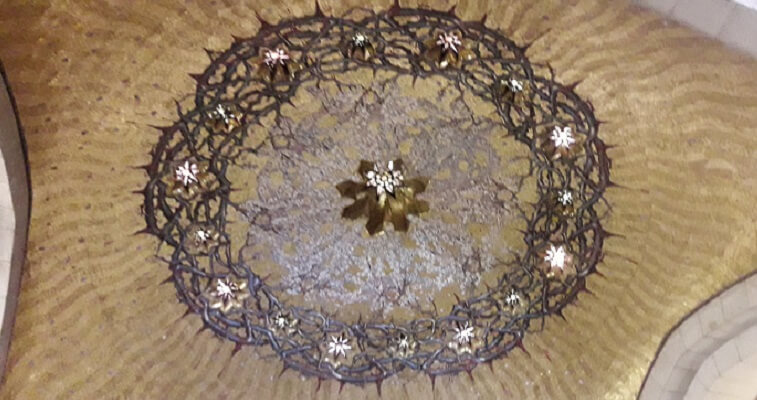
Church of the Flagellation
The crown of thorns represents the world’s ingratitude, where often significant efforts are wasted, the wicked prosper, and benefactors are repaid with betrayal. Rather than welcoming Jesus with a golden crown as a mark of honor, he was met with a crown of thorns, symbolizing mockery and judgment, ultimately reflecting a self-condemnation by those who rejected him. The mystery of the crown of thorns instructs us on confronting the ingratitude we face, a message Antonio Barluzzi encapsulates through the Church of the Flagellation’s exquisite artistry.
Barluzzi’s churches stand out for their ability to narrate the historical events of their locations through their design, incorporating architecture, artwork, layout, materials, and the overall setup of the premises. In this spirit, The entrance to the Church of the Flagellation mirrors the portal of Mary’s Tomb in the Jehoshaphat Valley, crafted by Queen Melisenda and the Templars as a sanctum of mysteries during the Crusades. This architectural homage to Mary’s tomb by Barluzzi underscores his reverence for the rosary’s role in fostering a profound comprehension of Jesus’ life events under Mary’s tutelage. Adorning the Façade walls are enigmatic symbols that may initially seem akin to Freemason insignia. However, many are actually reliefs depicting the Passion’s instruments of torture, accompanied by a poignant quote from John: “Every one that is of the truth heareth my voice” (John 18:37).
The church’s layout consists of two small, complete, symmetrical squares merged into a singular area, suggesting the dual nature of reality. The inner section, housing the altar, serves as the stage for the liturgical drama, while the surrounding area is designated for congregational prayer. Encased by three walls, the interior is illuminated by stunning stained glass windows featuring vivid paintings. On the eastern side, depictions of the crowd driving Jesus towards his demise contrast sharply with images on the southern side, where Barabbas is exalted as a hero by the masses. These contrasting visuals evoke a sense of societal disarray, highlighting the inversion of justice where the righteous are persecuted, and the malevolent are celebrated.
At this location, Pontius Pilate presided over the trial of Jesus. That night, Pilate’s wife had a dream indicating Jesus was innocent and implored Pilate to release him. Consequently, Pilate presented the crowd with the option to pardon one individual, as was customary on the eve of Passover. However, the crowd chose Barabbas, a robber and murderer, over Jesus, calling for Jesus’ execution. Pilate acquiesced to their demands. The crowd sought the demise of the blameless, favoring the might and brutality of power.
In the third window from the north, the depiction of Pontius Pilate washing his hands conveys his proclamation of innocence regarding Jesus’ blood, as stated in Matthew 27:24. Barluzzi suggests that Pilate’s guilt mirrors the world’s madness and ingratitude, attributed to those claiming innocence due to ignorance or reluctance to stand firm and act. Pilate embodies this guilt. Furthermore, the act of washing hands symbolizes hypocrisy and puritanism, further contributing to the world’s malevolence.
The interior colors of the church—brown, black, gold—evoke a profound sense of sorrow, further deepened by the harrowing scenes depicted in the windows. This atmosphere drives visitors to lift their eyes upwards to escape the unsettling imagery below. However, upon looking up, they encounter a flat golden dome overhead, housing a vast crown of thorns featuring droplets of blood and tears. Barluzzi’s artistry makes churchgoers feel as though the immense crown of thorns atop the dome rests upon them, creating a sense of inescapability akin to the experience in the Church of All Nations in Gethsemane. This effect vividly reenacts the historical events commemorated by the church.
Escape from this seemingly hopeless condition—echoed in the chaotic human portrayals in the windows, the oppressive color scheme, and the overarching crown of thorns—is subtly suggested through star-shaped openings in the dome, nestled among the crown’s thorns. These apertures admit streams of blue sky light, symbolizing that redemption and liberation are attainable through suffering. The resolution to the world’s torment lies in a connection to the divine and spiritual realms, regardless of earthly circumstances. Within the crown of thorns, alongside the star-shaped vents, are also flowers symbolizing hope, faith, and the virtuous actions of individuals that herald new life post-mortem. This design intimates that even the barren thorns hold life within.
It’s crucial to recognize that historically, Christianity attributed the blame for Jesus’ condemnation and crucifixion to the Jewish people, portraying those who demanded his death as Jews. Yet, the Second Vatican Council in 1960 rectified this perspective, stating that Jews should not bear the blame for Jesus’ death. The council emphasized that the crowd demanding his crucifixion comprised individuals from various backgrounds, representing the entirety of humanity.
The Mystery of the Crowning with Thorns reminds us of our collective responsibility; we cannot claim innocence as long as we harbor the world’s malice in our hearts and reject the sovereignty and sanctity of Jesus—or the potential for holiness within us. This mystery imparts lessons on Worldly Contempt and Moral Courage, illustrating that the accolades and recognition the world offers are ultimately deceptive and lead to disillusionment. Even if we attain worldly success, power, and joy, we ultimately realize the futility of our endeavors. Thus, we shouldn’t pursue superficial status or power. Instead, prioritizing the reign and authority of Jesus in our lives is paramount, even if it appears that our efforts yield only a crown of thorns in return.
The Church of the Flagellation Chapel, one of the earliest churches designed by Barluzzi, was opened in 1929, roughly a year following the inauguration of All Nations Church. Despite its modest size, it stands unparalleled as a venue for reflecting on the Mystery of the Crown of Thorns. It’s highly recommended to wait for a quiet moment to spend quality time within the chapel, where standing by the altar allows one to feel the weight of the crown of thorns from the ceiling pressing upon you, piercing your heart with the world’s injustices. After acknowledging the burden of the crown, it’s uplifting to observe the stars and flowers intermingled with the thorns, reminding us of the promise of eternal life.
More about Barluzzi and the Italian presence in the Holy Land
Barluzzi embraced the austere lifestyle of a Franciscan monk, dedicating extensive hours to meditation before embarking on each architectural or artistic project. He deeply immersed himself in the narratives of the Gospel, seeking to uncover the divine mysteries within and drawing inspiration for his designs from prayer and meditation. His aim was for his architectural creations to evoke a sense of religious devotion and emotion among visitors. Barluzzi maintained a disciplined routine, attending Mass every morning at six, engaging in work throughout the day, and setting aside two hours for prayer in the afternoon. Often, he would spend many hours in contemplation without drafting a single line, sitting thoughtfully at his desk. His work was an act of devotion, undertaken with humility and gratitude for the opportunity to contribute to the sanctification of holy sites: “I feel the invincible need to dedicate myself to holy places, God willing… convinced that I was meant for it, not to showcase my talent, but to demonstrate the miracles God can accomplish through modest means.” His life’s work was devoted to the sacred edifices of the Holy Land, which consumed his thoughts, heart, and soul throughout his existence.




